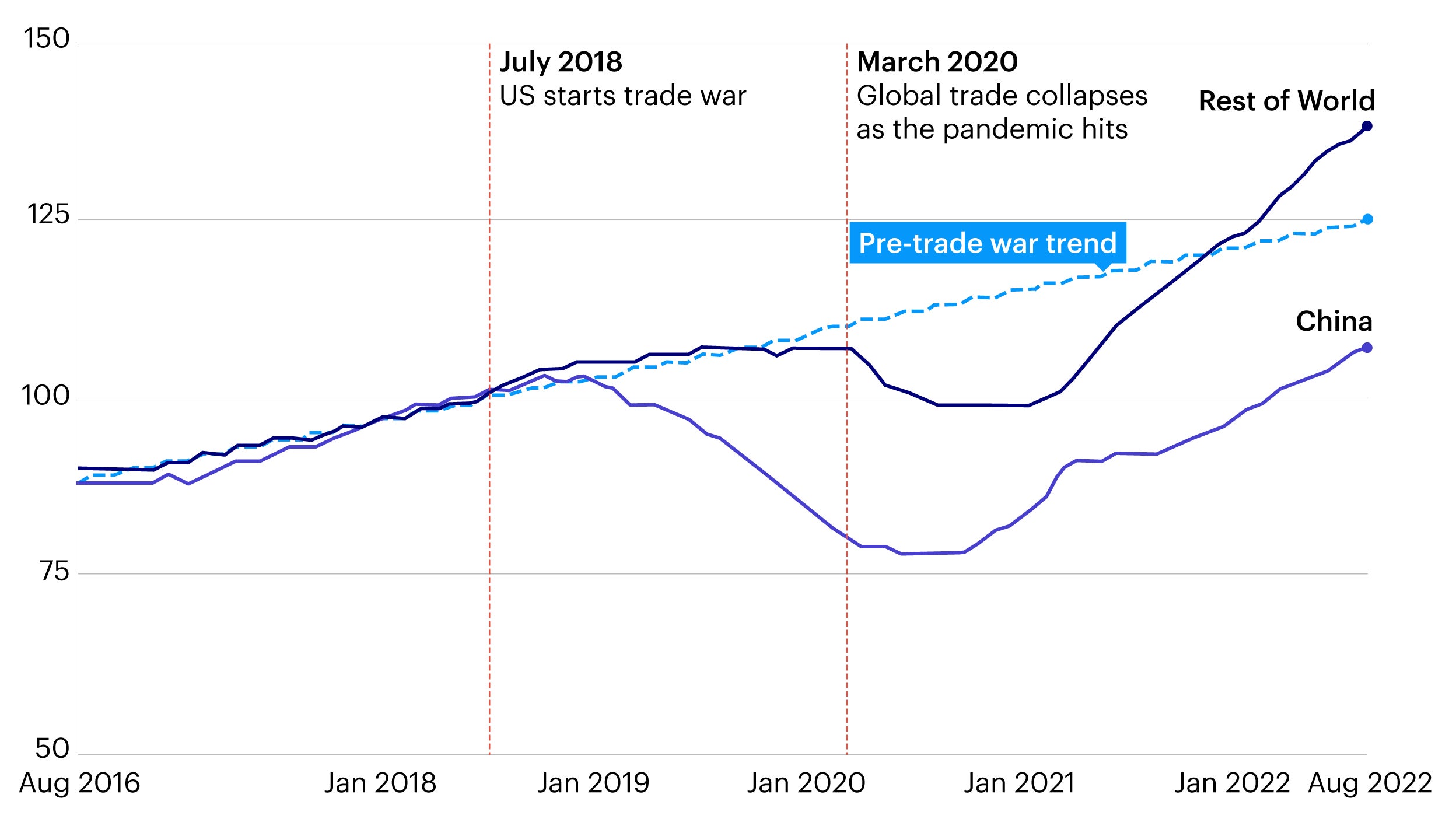US-China Trade Deadlock: A Breakdown Of The Breakthrough

Table of Contents
The History of the US-China Trade Deadlock
The US-China trade dispute didn't erupt overnight; it's the culmination of years of simmering tensions. The initial sparks ignited under the Trump administration, with the imposition of tariffs on various Chinese goods, ostensibly to address issues like intellectual property theft and trade imbalances. These actions were met with swift and significant retaliatory tariffs from China, setting the stage for a full-blown trade war.
- Initial imposition of tariffs (2018): The Trump administration initiated Section 301 tariffs, targeting hundreds of billions of dollars worth of Chinese imports.
- China's retaliatory tariffs: China responded in kind, imposing tariffs on US agricultural products, impacting American farmers significantly.
- Periods of negotiation and subsequent breakdowns: Several rounds of high-level negotiations took place, marked by moments of apparent progress followed by setbacks and renewed escalation of tariffs.
- Impact on global supply chains and market volatility: The trade war disrupted global supply chains, leading to increased costs for businesses and consumers worldwide, and creating significant market volatility.
- The role of intellectual property theft accusations: Accusations of intellectual property theft and forced technology transfer by Chinese companies played a central role in justifying the US's initial actions, fueling the tensions.
Factors Contributing to the Potential Breakthrough
The potential shift in the US-China trade relationship is a complex phenomenon driven by several intertwined factors. While no single cause can be isolated, several contributing elements are discernible.
- Changing economic landscapes: Both the US and China face evolving economic realities. The US is grappling with inflation and supply chain issues, while China is experiencing slower-than-expected economic growth. These internal pressures create incentives for de-escalation.
- Domestic political pressures: In the US, shifting political landscapes and concerns about the economic impact of the trade war have led to calls for a more pragmatic approach. Similarly, internal pressures within China also contribute to a need for stability.
- The impact of the COVID-19 pandemic: The pandemic exposed vulnerabilities in global supply chains, highlighting the need for greater cooperation and diversification. This has fostered a renewed focus on resolving trade disputes.
- Potential compromises and concessions: Any breakthrough requires compromise from both sides. This could involve adjustments to tariff levels, improved market access for US companies in China, and strengthened intellectual property rights protections.
- The involvement of international organizations: While not directly mediating, organizations like the World Trade Organization (WTO) play an indirect role by setting standards and providing a framework for resolving trade disputes.
Key Aspects of the Potential Trade Agreement (if applicable)
While a comprehensive agreement may still be under negotiation, potential key aspects could include:
- Tariff reductions or removal: A phased reduction or complete removal of existing tariffs is crucial for restoring normal trade flows.
- Market access improvements: Increased market access for US companies in China's various sectors, as well as reciprocal access for Chinese companies in the US market.
- Intellectual property rights protection: Stronger mechanisms to protect US intellectual property in China, addressing concerns about theft and forced technology transfer.
- Mechanisms for dispute resolution: Establishing clear channels for resolving future trade disputes, preventing escalation into another tariff war.
- Enforcement of agreed-upon terms: A robust mechanism for monitoring compliance and addressing violations of the agreement is essential.
Economic and Geopolitical Implications
The consequences of a US-China trade breakthrough extend far beyond the two nations involved. The implications are wide-ranging and profound.
- Impact on global supply chains: Easing tensions could lead to greater stability in global supply chains, reducing disruptions and costs for businesses worldwide.
- Effects on inflation and consumer prices: Reduced tariffs could help lower inflation and consumer prices in both the US and other countries.
- Changes in the global trade landscape: The outcome could influence trade relations between other countries and potentially lead to shifts in global trade patterns.
- Shifts in the US-China geopolitical relationship: Improved trade relations could signal a broader improvement in the overall US-China relationship, though geopolitical tensions might remain in other areas.
- Implications for other countries: Countries heavily reliant on trade with either the US or China will experience direct economic consequences depending on the nature of the agreement.
Conclusion
The potential breakthrough in the US-China trade deadlock marks a significant turning point in the complex relationship between these two economic giants. While the details and long-term implications remain to be seen, understanding the factors driving this shift is crucial for businesses, investors, and policymakers worldwide. The ongoing US-China trade negotiations remain a dynamic situation requiring close observation.
Call to Action: Stay informed about the evolving US-China trade relations. Continue to monitor developments in the ongoing US-China trade negotiations to understand the full impact of this potential breakthrough and adapt your strategies accordingly. Understanding the nuances of the US-China trade deadlock is key to navigating the ever-changing global economic landscape.

Featured Posts
-
 Rekord Ovechkina 12 Ya Pozitsiya V Spiske Luchshikh Snayperov Pley Off N Kh L
May 16, 2025
Rekord Ovechkina 12 Ya Pozitsiya V Spiske Luchshikh Snayperov Pley Off N Kh L
May 16, 2025 -
 Ovechkin On The Brink 893 Goals Closing In On Gretzky And The Nhl Record
May 16, 2025
Ovechkin On The Brink 893 Goals Closing In On Gretzky And The Nhl Record
May 16, 2025 -
 Nba Playoffs Cavaliers Vs Celtics Prediction And Betting Odds
May 16, 2025
Nba Playoffs Cavaliers Vs Celtics Prediction And Betting Odds
May 16, 2025 -
 Sigue El Partido Venezia Napoles En Directo Online
May 16, 2025
Sigue El Partido Venezia Napoles En Directo Online
May 16, 2025 -
 Chinas Role In The Fentanyl Epidemic A Former Us Envoys Assessment
May 16, 2025
Chinas Role In The Fentanyl Epidemic A Former Us Envoys Assessment
May 16, 2025
